The Power of Positive Reinforcement in Team Meetings
Introduction
In today's fast-paced work environment, it's crucial for organizations to find effective ways to keep their teams motivated, engaged, and productive. One often underutilized strategy is the implementation of positive reinforcement in team meetings. By recognizing and rewarding employees' efforts and achievements, leaders can foster a supportive and collaborative atmosphere that ultimately leads to better results. In this article, we will delve into the power of positive reinforcement in team meetings, explore its impact on employee motivation and performance, and provide practical tips for incorporating it into your organization's meeting culture. So, let's dive in and unlock the potential of positive reinforcement to transform your team's productivity and overall satisfaction.
Understanding Positive Reinforcement
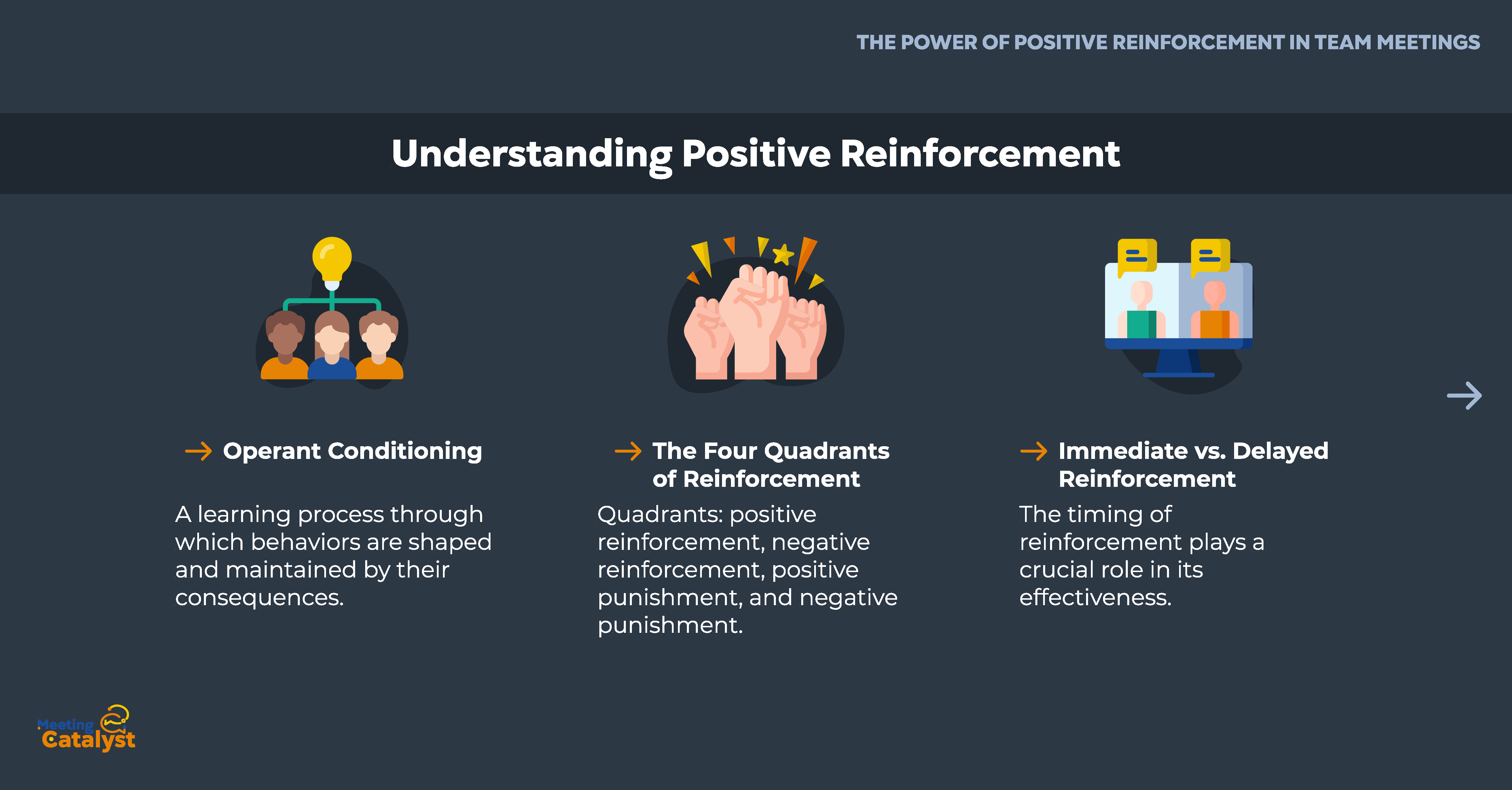
Before we dive into the practical aspects of incorporating positive reinforcement in team meetings, it's important to understand what it is and how it works. Positive reinforcement is a psychological principle rooted in the field of behavioral psychology. It involves the addition of a pleasant stimulus or reward to encourage desired behaviors and increase the likelihood of their repetition.
Operant Conditioning: At the core of positive reinforcement lies the concept of operant conditioning, a learning process through which behaviors are shaped and maintained by their consequences. By providing a reward or positive feedback, you create an association between the behavior and a positive outcome, making it more likely to occur again in the future.
The Four Quadrants of Reinforcement: Positive reinforcement is just one of the four quadrants of reinforcement, which also include negative reinforcement, positive punishment, and negative punishment. Among these, positive reinforcement is considered the most effective and least harmful approach to influencing behavior.
Immediate vs. Delayed Reinforcement: The timing of reinforcement plays a crucial role in its effectiveness. Immediate reinforcement, provided as soon as the desired behavior occurs, is generally more effective than delayed reinforcement. However, some situations may require a delay, such as when rewards are contingent on meeting specific goals or deadlines.
In the context of team meetings, positive reinforcement can take various forms, from verbal praise and recognition to tangible rewards, such as bonuses or other incentives. By understanding the principles behind positive reinforcement, you'll be better equipped to leverage its power in your team meetings and create an environment that fosters motivation, engagement, and productivity.
Benefits of Positive Reinforcement in Team Meetings
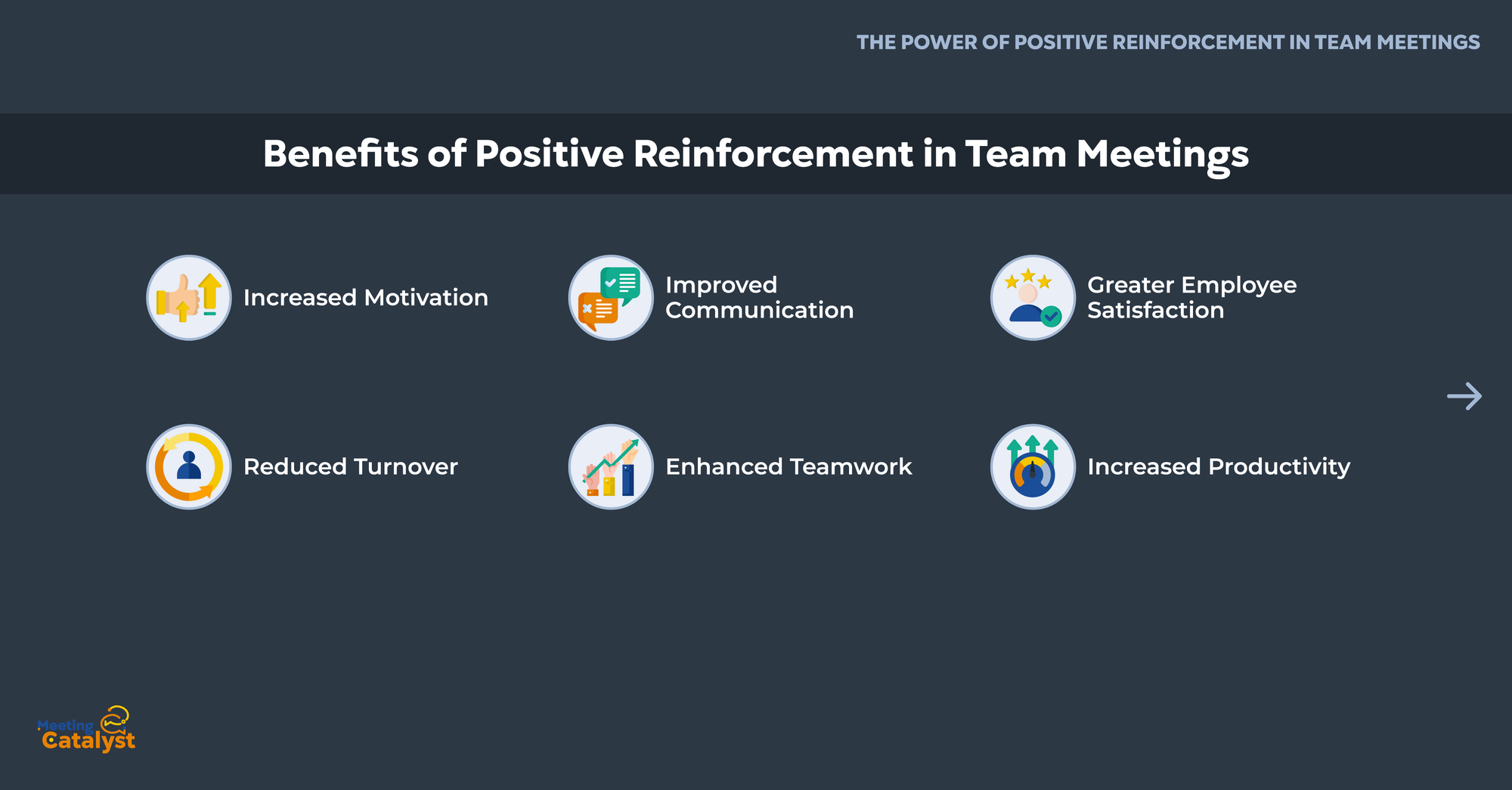
Incorporating positive reinforcement into your team meetings can have a significant impact on your team's dynamics and overall performance. By acknowledging and rewarding desired behaviors, you not only encourage their repetition but also create a supportive and engaging atmosphere. Here are some key benefits of using positive reinforcement in team meetings:
Increased Motivation: When team members feel valued and recognized for their contributions, they are more likely to be motivated and committed to their work. Positive reinforcement boosts morale and helps create a culture where employees feel encouraged to perform at their best.
Improved Communication: Acknowledging achievements and fostering a positive environment promotes open communication among team members. This, in turn, leads to better collaboration, as employees feel comfortable discussing ideas and sharing feedback.
Greater Employee Satisfaction: Receiving positive reinforcement contributes to an individual's sense of job satisfaction. Happier employees are more likely to be engaged, productive, and loyal to the organization.
Reduced Turnover: When team members feel appreciated and recognized for their efforts, they are less likely to look for opportunities elsewhere. This leads to lower turnover rates, which ultimately saves the company time and resources in hiring and training new employees.
Enhanced Teamwork: By rewarding collaboration and teamwork, positive reinforcement helps to strengthen bonds among team members, fostering a sense of camaraderie and unity.
Increased Productivity: A motivated and engaged team is more likely to be productive and efficient, ultimately contributing to the company's overall success.
By harnessing the power of positive reinforcement in your team meetings, you can create a work environment that is both supportive and performance-driven. This will, in turn, lead to a more motivated, satisfied, and productive workforce.
Practical Ways to Incorporate Positive Reinforcement in Meetings
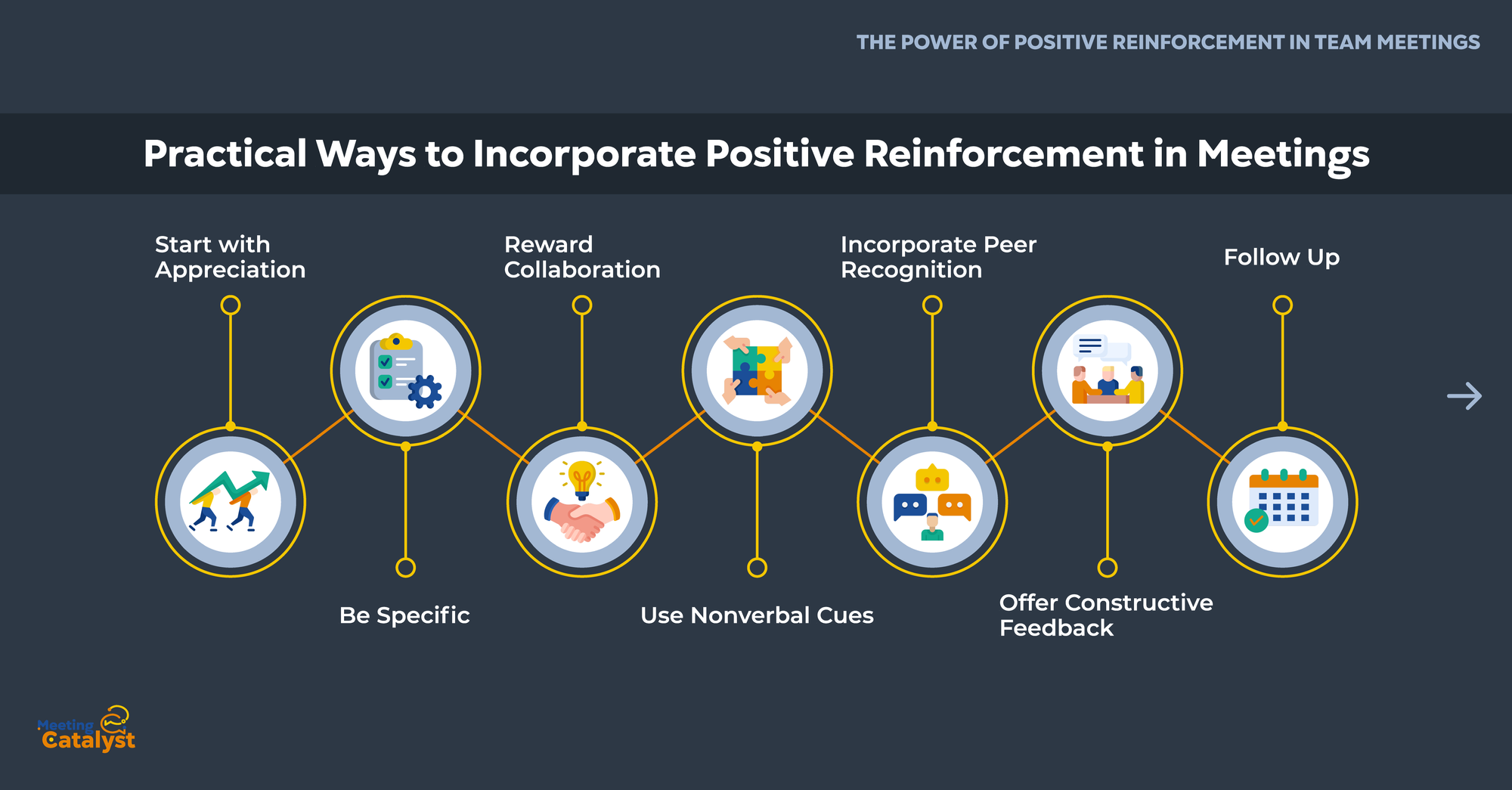
Creating a positive atmosphere in your team meetings requires a conscious effort to recognize and celebrate your team members' achievements. Here are some practical ways to incorporate positive reinforcement into your meetings:
Start with Appreciation: Begin each meeting by acknowledging the successes and accomplishments of your team members. This sets a positive tone for the meeting and demonstrates that you value their efforts.
Be Specific: When praising a team member, be specific about their accomplishments and the impact they had on the team or project. This not only makes the praise more meaningful but also helps other team members understand the desired behaviors and outcomes.
Reward Collaboration: Encourage teamwork by recognizing and rewarding collaborative efforts. This fosters a sense of unity and encourages further collaboration among team members.
Use Nonverbal Cues: Positive reinforcement goes beyond verbal praise. Nonverbal cues, such as smiling, nodding, and maintaining eye contact, can also convey appreciation and encouragement.
Incorporate Peer Recognition: Create opportunities for team members to acknowledge each other's contributions. This not only strengthens bonds among team members but also adds credibility to the praise, as it comes from their peers.
Offer Constructive Feedback: While it's important to focus on the positives, don't shy away from offering constructive feedback. Frame it in a way that highlights opportunities for growth and improvement, rather than focusing on shortcomings.
Follow Up: Ensure that positive reinforcement doesn't end with the meeting. Follow up with team members individually to offer further encouragement, discuss challenges, and provide additional support as needed.
By incorporating these strategies into your team meetings, you can create an environment where positive reinforcement becomes an integral part of your team's culture. This, in turn, will help foster a motivated, engaged, and high-performing workforce.
The Role of Leadership in Positive Reinforcement
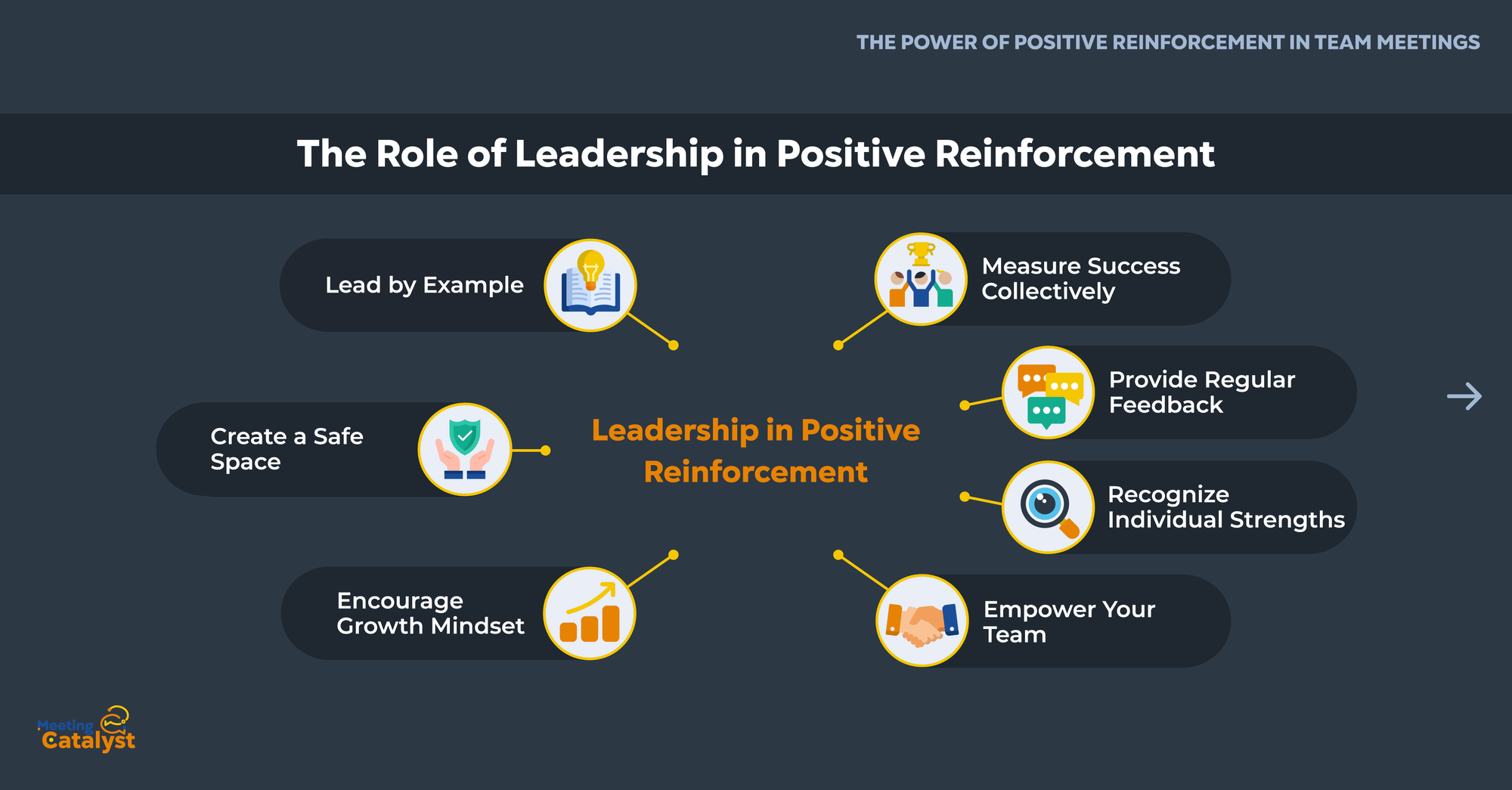
Leaders play a crucial role in promoting a culture of positive reinforcement within their teams. By modeling the desired behaviors and attitudes, leaders can set the stage for a supportive and uplifting environment. Here are some ways in which leaders can effectively incorporate positive reinforcement into their leadership style:
Lead by Example: Demonstrating your own commitment to recognizing and appreciating the efforts of your team members will encourage them to do the same. Be proactive in offering praise and support to your team members, and others will follow suit.
Create a Safe Space: Foster an environment where team members feel comfortable sharing their thoughts, ideas, and achievements. Encourage open communication and create a culture of psychological safety, where team members can express themselves without fear of judgment or retribution.
Encourage Growth Mindset: Promote a growth mindset among your team members by emphasizing the value of learning from mistakes and embracing challenges. By focusing on the process and effort rather than just the outcome, you create a more supportive and nurturing environment.
Empower Your Team: Empower your team members by entrusting them with responsibilities and decision-making authority. This demonstrates your confidence in their abilities and encourages them to take ownership of their work, which in turn fosters a sense of pride and accomplishment.
Recognize Individual Strengths: Acknowledge and celebrate the unique strengths and talents of each team member. By recognizing their individual contributions, you help them feel valued and appreciated, which boosts morale and motivation.
Provide Regular Feedback: Make a habit of providing regular, ongoing feedback to your team members, both positive and constructive. This not only helps them understand their strengths and areas for improvement but also shows that you are invested in their growth and success.
Measure Success Collectively: Encourage a sense of shared success by measuring and celebrating achievements as a team. This helps to create a strong sense of unity and reinforces the importance of teamwork and collaboration.
By embracing these leadership practices, you can effectively incorporate positive reinforcement into your management style, creating a more engaged, motivated, and high-performing team.
Recognizing Individual Strengths and Contributions
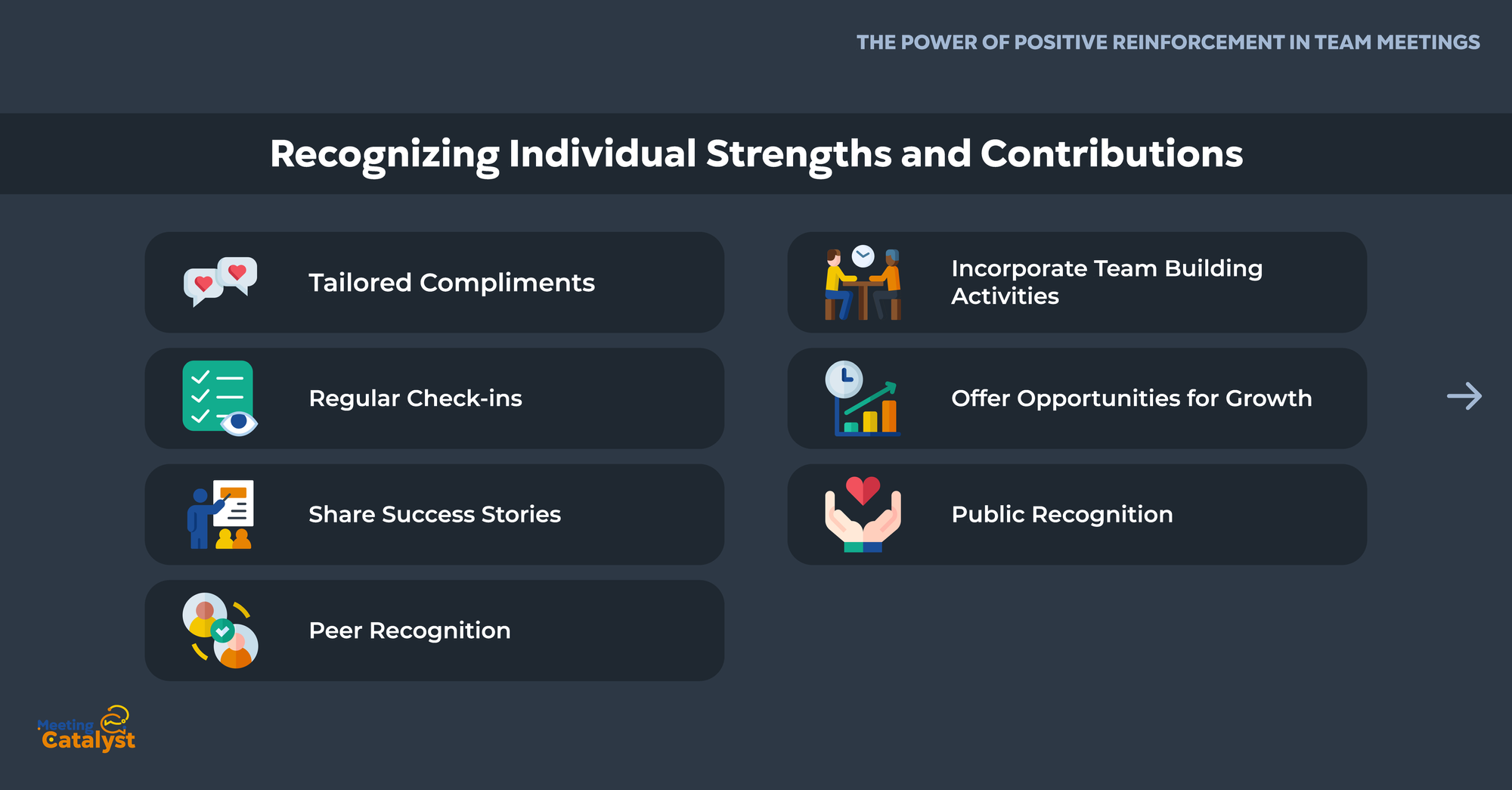
Acknowledging the unique skills and accomplishments of your team members is essential in fostering a positive and motivating work environment. By shining a light on each person's individual strengths and contributions, you not only boost their self-esteem but also encourage them to continue excelling in their roles. Here are some practical ways to recognize individual strengths and contributions in team meetings:
Tailored Compliments: Offer genuine, specific compliments to team members for their accomplishments or efforts. Personalized praise is much more impactful than generic compliments, as it demonstrates that you truly recognize and appreciate their unique qualities.
Regular Check-ins: Schedule regular one-on-one check-ins with your team members to discuss their progress and offer feedback on their performance. This personalized attention shows that you value their input and care about their growth and development.
Share Success Stories: Dedicate a portion of team meetings to sharing success stories and celebrating individual achievements. This not only highlights the team member's accomplishments but also provides inspiration and motivation for others to strive for similar success.
Peer Recognition: Encourage peer recognition by providing opportunities for team members to acknowledge and appreciate one another's strengths and contributions. This helps to foster a supportive and collaborative environment where everyone feels valued.
Incorporate Team Building Activities: Integrate team building activities into your meetings that highlight individual strengths and talents. This not only encourages collaboration and camaraderie but also provides a platform for team members to showcase their unique skills.
Offer Opportunities for Growth: Present team members with opportunities to further develop their skills and talents, such as attending workshops, taking on new projects, or leading initiatives. This demonstrates your commitment to their growth and encourages them to continue refining their abilities.
Public Recognition: Publicly acknowledge outstanding achievements and contributions, either during team meetings or through company-wide communication channels. This not only validates the individual's hard work but also boosts their visibility within the organization.
By consistently recognizing individual strengths and contributions, you create an environment where team members feel valued, motivated, and empowered to reach their full potential.
Balancing Positive Reinforcement with Constructive Feedback
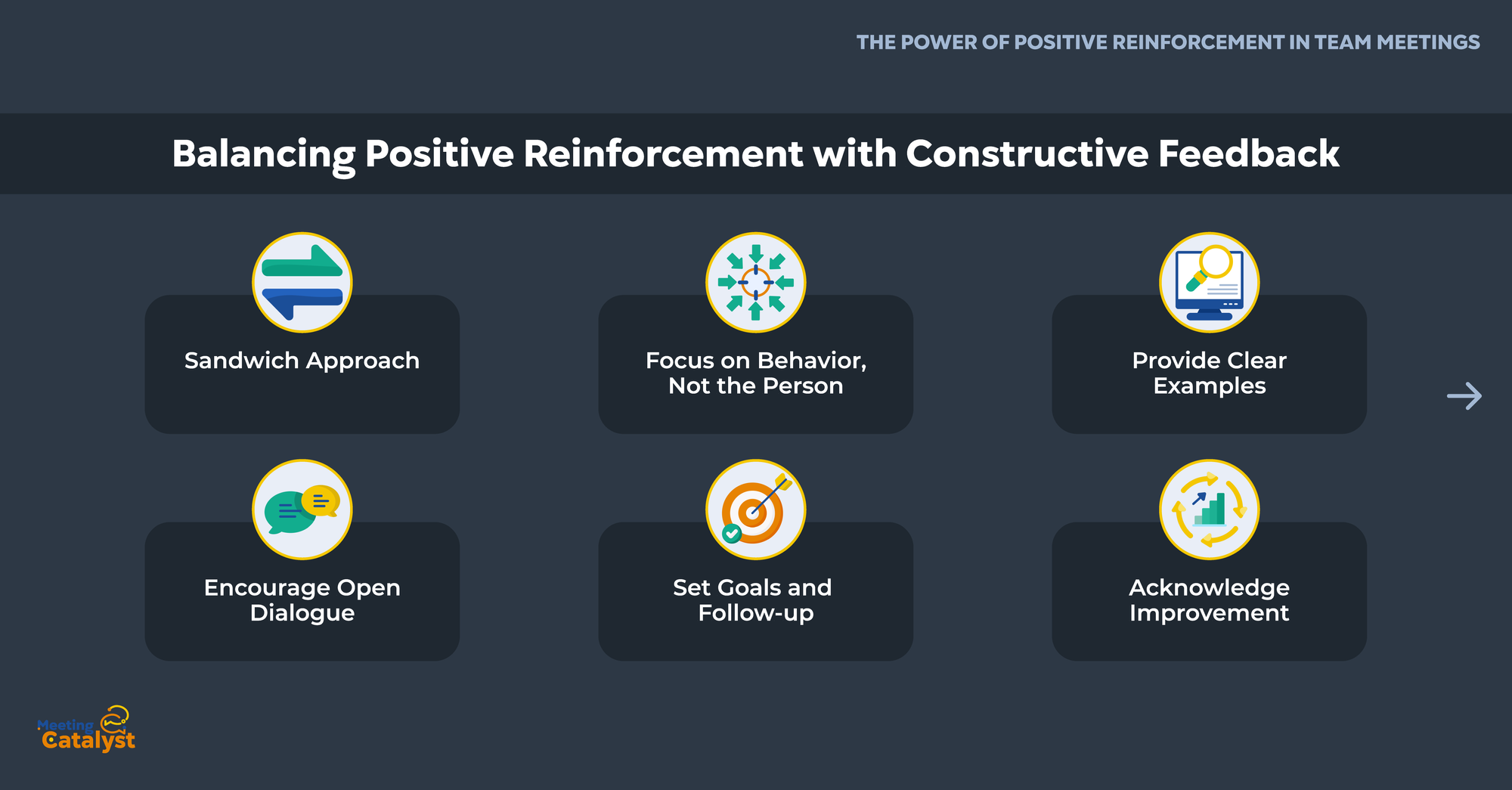
While positive reinforcement is essential for creating an uplifting work environment, it is also crucial to balance it with constructive feedback. This approach ensures that team members have the necessary guidance to improve and grow professionally. Here's how you can effectively balance positive reinforcement with constructive feedback in team meetings:
Sandwich Approach: Utilize the sandwich approach, which involves offering praise before and after delivering constructive feedback. This technique helps to soften the impact of the feedback and demonstrates your appreciation for the individual's efforts.
Focus on Behavior, Not the Person: When providing feedback, concentrate on specific behaviors or actions that need improvement rather than criticizing the person. This helps to create a more objective, solution-focused discussion.
Provide Clear Examples: Offer clear examples to illustrate the behavior that needs improvement, along with suggestions on how to enhance performance. This helps to ensure that your team members fully understand the feedback and can implement the necessary changes.
Encourage Open Dialogue: Foster an environment where team members feel comfortable discussing their concerns and asking questions. This open dialogue allows for a better understanding of the feedback and encourages collaboration in finding solutions.
Set Goals and Follow-up: After providing feedback, work with your team members to establish specific goals for improvement. Schedule regular follow-up meetings to assess progress and offer additional guidance as needed.
Acknowledge Improvement: Recognize and praise your team members when they demonstrate progress or implement positive changes as a result of the feedback. This recognition reinforces the value of constructive feedback and motivates them to continue striving for improvement.
By skillfully balancing positive reinforcement with constructive feedback, you support your team's growth and development while maintaining a positive and empowering work environment. This approach ultimately contributes to the overall success and productivity of your team meetings and the organization as a whole.
Measuring the Impact of Positive Reinforcement on Team Performance
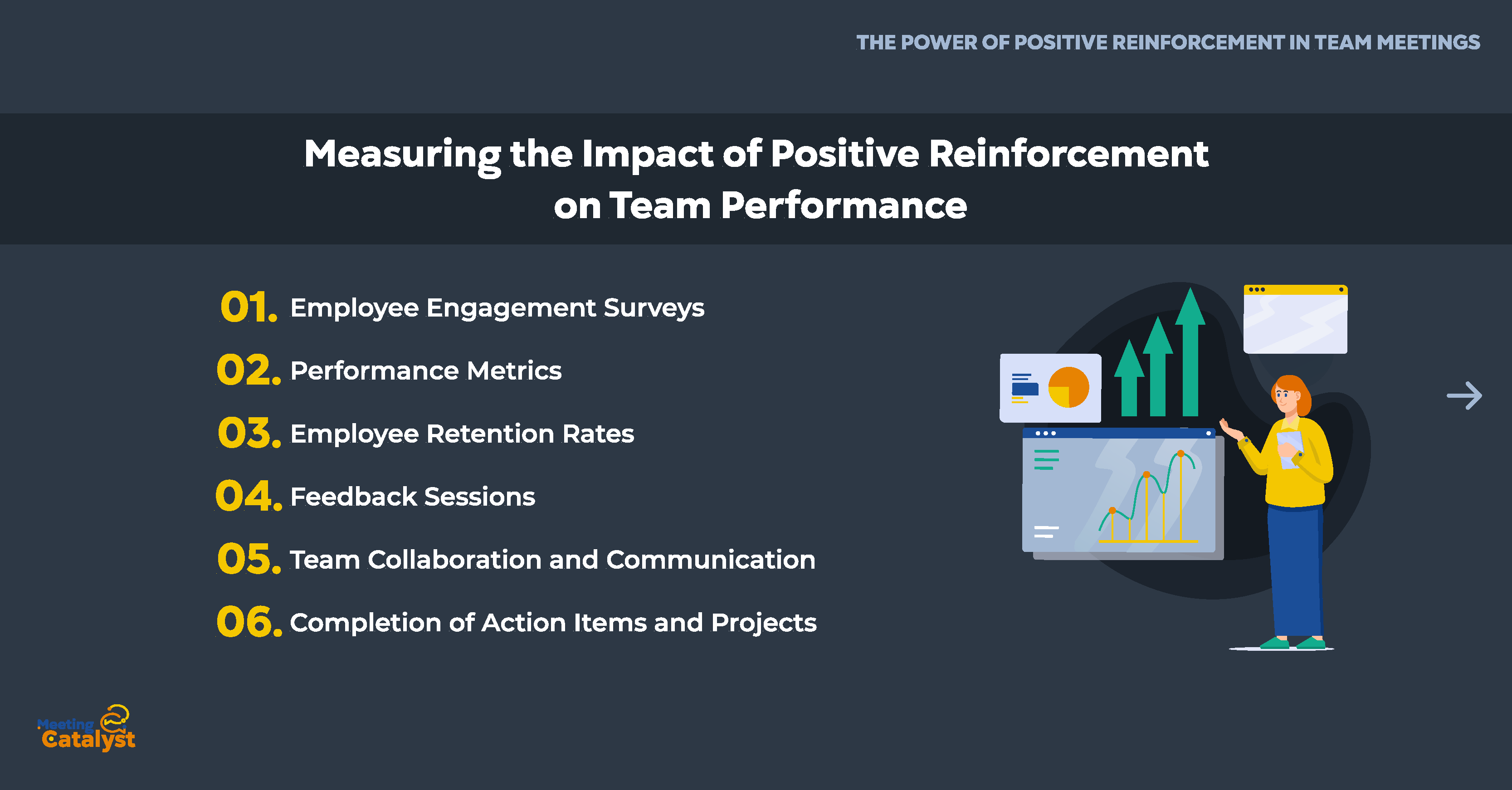
To fully understand the benefits of incorporating positive reinforcement in team meetings, it is essential to measure its impact on team performance. By evaluating the effectiveness of your efforts, you can make adjustments and improvements as needed. Here are some practical ways to measure the impact of positive reinforcement on team performance:
Employee Engagement Surveys: Conduct regular employee engagement surveys to gauge the level of satisfaction and motivation within the team. By comparing the results before and after implementing positive reinforcement strategies, you can assess the overall effectiveness of your approach.
Performance Metrics: Track key performance indicators (KPIs) relevant to your team's goals and objectives. By monitoring these metrics, you can identify trends and patterns that may be linked to the use of positive reinforcement.
Employee Retention Rates: Compare employee retention rates before and after incorporating positive reinforcement in team meetings. Higher retention rates can indicate increased job satisfaction and a more positive work environment.
Feedback Sessions: Schedule regular feedback sessions with team members to solicit their thoughts and opinions on the effectiveness of positive reinforcement in meetings. This first-hand insight can provide valuable information on what is working well and what may need improvement.
Team Collaboration and Communication: Observe the level of collaboration and communication within the team. An increase in these areas can indicate that positive reinforcement has fostered a more supportive and open work environment.
Completion of Action Items and Projects: Monitor the progress and completion of action items and projects within the team. If you notice an improvement in the timely completion of tasks, it may be a result of the increased motivation and engagement brought about by positive reinforcement.
By consistently measuring the impact of positive reinforcement on team performance, you can fine-tune your approach to ensure that your efforts are yielding the desired results. This data-driven strategy will enable you to optimize your team meetings, ultimately leading to improved productivity and overall team success.
Overcoming Challenges in Implementing Positive Reinforcement
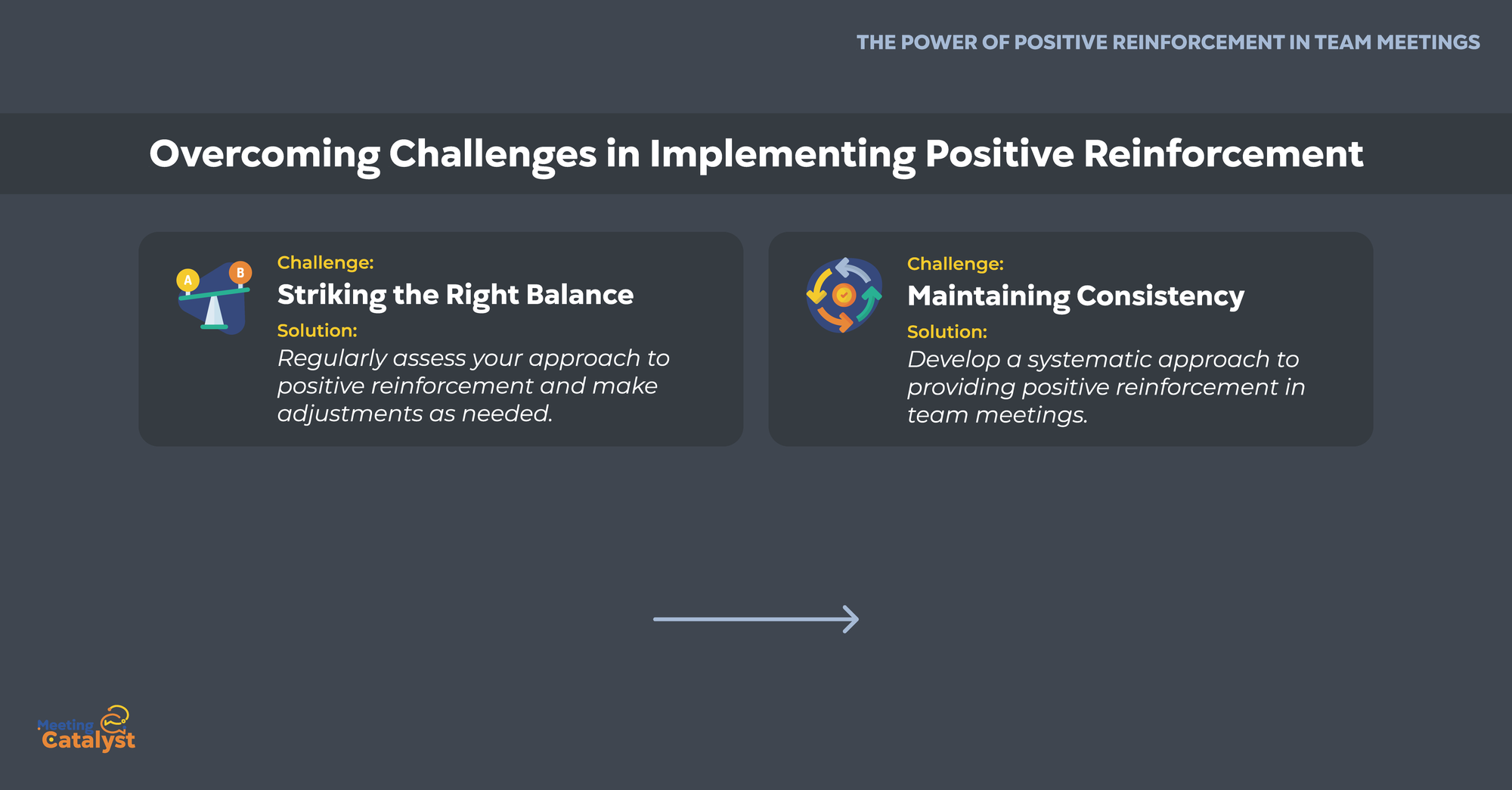
While positive reinforcement has proven to be a powerful tool in team meetings, it is not without its challenges. To effectively utilize positive reinforcement and reap its benefits, it's crucial to recognize and address these potential obstacles. Here are some common challenges and practical solutions:
Striking the Right Balance: Avoid overpraising, as it can diminish the value of your positive reinforcement. Focus on acknowledging genuine achievements and progress, and strike the right balance between praise and constructive feedback.
Solution: Regularly assess your approach to positive reinforcement and make adjustments as needed. Ensure that your feedback is specific, genuine, and well-timed to maintain its effectiveness.
Avoiding Favoritism: It is essential to ensure that positive reinforcement is distributed fairly among team members, as perceived favoritism can lead to resentment and decreased morale.
Solution: Make a conscious effort to recognize the strengths and contributions of each team member, and consistently apply positive reinforcement to all.
Maintaining Consistency: Inconsistency in applying positive reinforcement can confuse team members and undermine its effectiveness.
Solution: Develop a systematic approach to providing positive reinforcement in team meetings, and ensure that all team leaders and managers are aligned in their approach.
Addressing Underperformance: While positive reinforcement is essential, it should not come at the expense of addressing underperformance or issues that need attention.
Solution: Combine positive reinforcement with constructive feedback and clear expectations to address any performance gaps effectively.
Measuring Impact: It can be challenging to determine the effectiveness of positive reinforcement, as its impact on team performance may not be immediately apparent.
Solution: Use the measurement techniques discussed in Section VIII to assess the impact of positive reinforcement on team performance and make data-driven decisions to optimize your approach.
By recognizing and addressing these challenges, you can effectively implement positive reinforcement in your team meetings, fostering a more positive, supportive, and productive work environment.
Conclusion
Incorporating positive reinforcement in team meetings is a powerful approach to boost morale, increase motivation, and enhance team performance. By understanding the importance of positive reinforcement, implementing practical strategies, and overcoming the associated challenges, you can cultivate a work environment that encourages growth, collaboration, and success.
Remember to:
- Understand the concept of positive reinforcement and its benefits in team meetings
- Incorporate positive reinforcement through various techniques, such as verbal praise, recognition, and rewards
- Embrace the role of leadership in fostering a positive and supportive environment
- Balance positive reinforcement with constructive feedback to address performance gaps effectively
- Measure the impact of your efforts on team performance and make data-driven adjustments as needed
As you work towards integrating positive reinforcement into your team meetings, you'll be fostering a more engaging and supportive atmosphere where individuals can thrive, and your team can reach its full potential. With a culture of positive reinforcement in place, your organization will be better equipped to tackle challenges, adapt to change, and achieve lasting success.